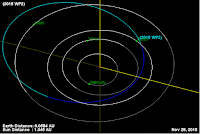Asteroid
2015 VE65 passed by the Earth at a distance of 18 410 000 km (47.9 times
the average distance between the Earth and the Moon, or 12.3% of the
average distance between the Earth and the Sun), slightly after 4.10 pm
GMT on Monday 23 November 2015. There
was no danger of the asteroid hitting us, though had it done so it
would have presented a genuine threat. 2015 VE65 has an estimated
equivalent diameter of 36-110 m (i.e. a spherical body with the same
mass would be 36-110 m in diameter), and an object towards the upper end
of this range would pass through the atmosphere and directly impact the
ground with a force of about 55 megatons (about 3235 times the
explosive energy of the Hiroshima bomb), causing devastation over a wide
area and creating a crater over 1.3 km across, and resulting in global
climatic problems that could last for years or even decades.
The calculated orbit of 2015 VE65. JPL Small Body Database.
2015 VE65 was discovered on 7 November 2015 (16 days after its closest approach to the Earth) by the University of Arizona's Mt. Lemmon Survey at the Steward Observatory on
Mount Lemmon in the Catalina Mountains north of Tucson. The designation
2015 VE65 implies that the asteroid was the 1630th object (object E65)
discovered in the first half of November 2015 (period 2015 V).
2015 VE65 has a 462 day orbital period and an eccentric orbit tilted at an
angle of 19.3° to the plane of the Solar System that takes it from 0.78
AU from the Sun (i.e. 78% of the average distance at which the Earth
orbits the Sun, and slightly outside the orbit of Venus) to 1.56 AU from the Sun (i.e. 156% of the average
distance at which the Earth orbits the Sun, slightly more than the
distance at which Mars orbits the Sun). It is therefore classed as an
Apollo Group Asteroid (an asteroid that is on average further from the
Sun than the Earth, but which does get closer).
See also...
 Asteroid 2015 WP2 passes the Earth. Asteroid
2015 WP2 passed by the Earth at a distance of 229 800 km (0.6
times the average distance between the Earth and the Moon, or 0.16% of
the average distance between the Earth and the Sun; but 575.4 times as far from the Earth as the International...
Asteroid 2015 WP2 passes the Earth. Asteroid
2015 WP2 passed by the Earth at a distance of 229 800 km (0.6
times the average distance between the Earth and the Moon, or 0.16% of
the average distance between the Earth and the Sun; but 575.4 times as far from the Earth as the International... Asteroid 2015 VV2 passes the Earth. Asteroid
2015 VV2 passed by the Earth at a distance of 6 623 000 km (17.2
times the average distance between the Earth and the Moon, or 4.43% of
the average distance between the Earth and the Sun), slightly after
10.30
pm on Wednesday 18 November 2015...
Asteroid 2015 VV2 passes the Earth. Asteroid
2015 VV2 passed by the Earth at a distance of 6 623 000 km (17.2
times the average distance between the Earth and the Moon, or 4.43% of
the average distance between the Earth and the Sun), slightly after
10.30
pm on Wednesday 18 November 2015... Asteroid 2015 VD105 passes the Earth. Asteroid
2015 VD105 passed by the Earth at a distance of 2 777 000 km (7.22
times the average distance between the Earth and the Moon, or 1.86% of
the average distance between the Earth and the Sun), slightly before 4.25
pm on Monday 16 November...
Asteroid 2015 VD105 passes the Earth. Asteroid
2015 VD105 passed by the Earth at a distance of 2 777 000 km (7.22
times the average distance between the Earth and the Moon, or 1.86% of
the average distance between the Earth and the Sun), slightly before 4.25
pm on Monday 16 November...
Follow Sciency Thoughts on Facebook.

